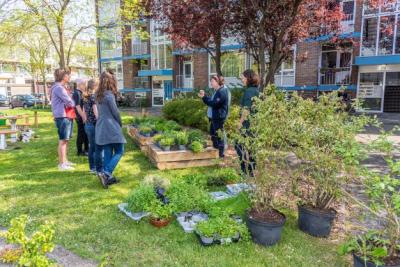Description
Due to urbanization, the quality and quantity of green space within the city is under pressure. Finding a balance between function and quality for people and nature is challenging. Green spaces must not only meet the different needs of residents but also contribute to important tasks such as increasing biodiversity and climate resilience.
The city’s post-war districts have many public green spaces. However, because they are often laid out as lawns, they are of little significance for biodiversity. Besides, they are not used by the residents either.
By engaging citizens we aimed to find, apply and test a small scalable project to increase biodiversity and the enhancement of community among residents living in the neighbourhood located in Leiden Zuidwest.
This resulted in three small herb-gardens located in the public green areas. Six residents were engaged throughout the project and currently maintain these gardens together.
When and Where
Policy Context
Participants
Methodologies
- Co-design with a small group
- Realization of the herb-gardens and knowledge-sharing about gardening
Impact
Most of the small herb or vegetable gardens in public spaces in Leiden are bottom-up projects. Some local inhabitants contacted the municipality and asked for the possibility of a follow-up to BiodiverCities.
Besides, we organised together with Naturalis Biodiversity Center, Municipality Leiden, social housing providers and social workers information markets to inform and activate inhabitants about biodiversity and explain the possibilities they have to contribute.
Assessment
In addition to bottom-up projects, top-down projects are also necessary to include further all residents of the city into the making of the city. In addition to the goals for biodiversity, the project can also contribute to strengthen social cohesion.
